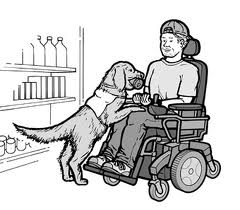I stumbled upon an interesting You Tube video about an Indiana property management company and whether they violated the ADA (Americans with Disabilities Act) and fair housing laws regarding service animals.
[button buttonlink=”http://youtu.be/1FWn5SNqmAU” buttonsize=”small” color=”000000″ hovercolor=”none” backgroundcolor=”FFFFFF” hoverbgcolor=”none” icon=”” rel=”prettyPhoto”]Watch You Tube Video[/button]
Interestingly enough, I read this article (see below for the full article or click the link) by the NVPOA (North Valley Property Owners Association) a few days before finding this You Tube video. If you are an owner/investor of an investment property, educate yourself on this topic. Keep up on the changing laws, and ask questions to experts that understand the implementation of these laws for investment properties.
[cornerbox color=”000000″ backgroundcolor=”a3a299″ bordercolor=”000000″ borderwidth=”1″ borderstyle=”dashed” icon=”” ]
How to Handle Requests for Assistance Animals
Published in: The Liaison April 2013 Newsletter
By: NVPOA (North Valley Property Owners Association)
Communities may set their own policies regulating pet ownership, but federal fair housing law does not consider assistance animals as pets, but rather as auxiliary aids that provide assistance to individuals with disabilities.
There’s also some confusion about which rules to apply. The two major federal laws protecting individuals with disabilities—the Americans with Disabilities Act (ADA) and the Fair Housing Act (FHA)—have very different rules on animals. It’s essential to understand that you must comply with the FHA rules, which offer much more leeway than the ADA on the types of assistance animals that must be permitted in conventional multifamily housing communities.
Under the FHA, it’s unlawful to refuse to make reasonable accommodations in rules, policies, practices, or services, when such accommodations may be necessary to afford individuals with disabilities equal opportunity to use and enjoy a dwelling, including a unit and common-use areas.
Among the most common are requests for exceptions to pet policies. Some communities enforce a no-pet policy, while others restrict the number, size, weight, breed, or species of animals or impose conditions, such as pet fees or deposits. Whatever your policy, you must consider a request for an exception to allow an individual with a disability to have an assistance animal as a reasonable accommodation.
To qualify for the accommodation, the assistance animal must be necessary to afford the individual with equal opportunity to use and enjoy the community. And there must be a relationship between the individual’s disability and the assistance that the animal provides. If those requirements are met, HUD says that communities must permit the assistance animal as an accommodation, unless it can demonstrate that the request is unreasonable—that is, allowing the
assistance animal would impose an undue financial or administrative burden or would fundamentally alter the nature of the community’s operations.
Fair Housing Law and Breed Restrictions
Fair housing experts Doug Chasick and Anne Sadovsky report frequent questions about requests for assistance animals that are restricted breeds, typically as emotional support animals. Often, Chasick says, the restricted breed animal has lived with the resident as a pet prior to the diagnosis of disability, and the need for the animal is compounded by the potential damage that separation from the animal would cause the qualified disabled person. How you should handle these requests depends on a number of factors, Sadovsky notes, including your community’s insurance coverage. In a 2006 memo, HUD officials specifically addressed insurance policy restrictions as a defense to refusing to grant reasonable accommodation requests involving a breed of dog that the owner’s insurance carrier considers dangerous. If the community’s
insurer would cancel or substantially increase the costs of the insurance policy, or adversely change the policy terms because of the presence of a certain breed of dog or a certain animal, then HUD will find that this imposes an undue financial and administrative burden on the housing provider, according to the memo. Nevertheless, the memo warned that investigators will check the owner’s claim by verifying with the owner’s carrier “and consider whether comparable insurance, without the restriction, is available on the market.”
There’s little other guidance on breed restrictions in conventional housing, but it may be helpful to look at HUD’s recent regulations on pet ownership in HUD-assisted housing for the elderly and persons with disabilities. In its accompanying comments, HUD didn’t specifically address breed restrictions, but it did explain how to evaluate requests for an assistance animal under the “direct threat” rule.
The comments noted that the FHA allows housing providers to exclude an assistance animal when that animal’s behavior poses a direct threat and its owner takes no effective action to control the animal’s behavior so that the threat is mitigated or eliminated. The determination of whether an assistance animal poses a direct threat must rely on an individualized assessment based on objective evidence about the specific animal in question, such as the animal’s current conduct or a recent history of overt acts. The assessment must consider:
The nature, duration, and severity of the risk of injury; The probability that the potential injury will actually occur; and Whether reasonable modifications of rules, policies, practices, procedures, or services will reduce the risk.
In evaluating a recent history of overt acts, HUD said that the housing provider must take into account whether the assistance animal’s owner has taken any action that has reduced or eliminated the risk. Examples would include specific training, medication, or equipment for the animal.
HUD also cautioned that the direct threat exception requires the existence of a significant risk—not one that’s remote or speculative risk. Consequently, the determination cannot be the result of fear or speculation about the types of harm or damage an animal may cause, or evidence about the harm or damage caused by other animals.
5 RULES FOR HANDLING REQUESTS FOR ASSISTANCE ANIMALS
Rule #1: Think FHA—not ADA—When It Comes to Animals
Rule #2: Don’t Take Narrow View of Assistance Animals
Rule #3: Don’t Treat Assistance Animals as Pets
Rule #4: Understand When and How to Ask for Documentation
Rule #5: Waive Pet Deposits and Fees for Assistance Animals
[/cornerbox]

